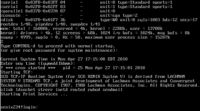Difference between revisions of "XENIX"
(→Platforms) |
|||
| Line 12: | Line 12: | ||
*[[Zilog Z8001]] I have only found sales literature that mentions this. | *[[Zilog Z8001]] I have only found sales literature that mentions this. | ||
*[[IBM PC]] This is 'easy' to find. | *[[IBM PC]] This is 'easy' to find. | ||
| − | *[[IBM 286]] As is this version.. | + | *[[IBM 286|IBM AT]] As is this version.. |
*[[IBM 386]] The 32bit ones will run on Qemu/Virtual PC | *[[IBM 386]] The 32bit ones will run on Qemu/Virtual PC | ||
Revision as of 06:12, 4 August 2010
Xenix was Microsoft port of AT&T unix. Based on v6, v7, SYSIII, and later SYSVrX. Because of the price of the OS, combined with cheap PC and compatibles, Xenix was the most widespread UNIX until the rise of Linux. Xenix due to it's inherent multiuser capabilities became wide spread in sales environments with POS (Point of Sales) terminals, and for scheduling systems commonly found in hotels, and restaurants. Occasionally you can still find this setup still running on aging hardware.
Xenix was a portable OS with ports to various platforms, but with the rise of the IBM PC, it primarily became an x86 based OS. Xenix eventually became OpenServer, then it was later merged with UNIXWare.
Contents
Platforms
As mentioned in the OEM guide pdf, Xenix supported the following platforms:
- PDP-11 No versions of this exist online.
- Apple Lisa The emulator idle can run this.
- Tandy TRS-80 Model II There are disk images floating around.
- Zilog Z8001 I have only found sales literature that mentions this.
- IBM PC This is 'easy' to find.
- IBM AT As is this version..
- IBM 386 The 32bit ones will run on Qemu/Virtual PC
Software
A quick list of a few software programs that were available on Xenix. I know the x86 platform was the most supported, I don't know how many (if any) of these made it to the less popular 68000 platform.
Microsoft
Microsoft made several of their programs in the 1980's available on the Xenix platform.
Languages
- C
- Basic
- Pascal
- Cobol
Applications
- Multiplan
- Word
Databases
- Foxpro
SCO
- SCO Professional
- SCO Lyrix
- SCO Integra
- SCO Manager
- SCO Multiview
| v • d • e UNIX Versions, Vendors and Related |
|---|
| Research Unix PDP-7 UNIX • V1 • V2 • V3 • V4 • V5 • V6 • V7 • V8 • V9 • V10 • LSX • MINI-UNIX • Unix/32V
AT&T - CB-UNIX • PWB/UNIX • USG UNIX • System III • System IV • System V BSD - 2.9 BSD • 2.10 BSD • 2.11 BSD • 3BSD • 4BSD • 4.1 BSD • 4.2 BSD • 4.3 BSD • 4.4 BSD BSD Descendants 386BSD • NetBSD • OpenBSD • FreeBSD • NeXTSTEP • Darwin Other - xv6 • AMIX • SunOS • Solaris • ULTRIX • A/UX • XENIX • AIX • Dell UNIX |
